 Technology will also match your tree to those of other users. This is a standard feature of most genealogy software. But the specific technology of this matching software is quite impressive.
Technology will also match your tree to those of other users. This is a standard feature of most genealogy software. But the specific technology of this matching software is quite impressive.It’s amazing to be able to track your ancestry. But it can also be a confusing process. This is especially true if you have a common surname. Even with a unique name, family trees can be complicated.
Even if you have a mass of documents, it can be difficult to work out exactly what they mean. Even more so if the writing is difficult to read.
So if you have tried every avenue by yourself and have come to a dead-end, using genealogy software is a great way to open up more options. As researching family history is so popular, there are quite a few around.
But don’t worry. We’ve put together this guide to the best genealogy software available. Read on for a rundown of what each software can do.
Benefits of Genealogy Software
Producing a family tree is generally pretty easy. You probably made one in kindergarten. But when you start to go back further than just your grandparents, things get a little more complicated. If you are able to track your ancestors back multiple centuries, then you will end up with a lot of information. Not all of which can be drawn on a piece of paper.
This information is data that needs to be kept somewhere. Genealogy software can help you with storing this data.
This is one of the most basic advantages of using genealogy software. But it is by no means the only one. Depending on the software, you will likely be able to search through official documents and find even more information.
Most of us probably don’t know where exactly our own birth certificates are. Let alone our great aunt’s cousin’s husband’s birth certificate. So access to records will make a massive difference to your research.
Some software will also connect you with other family trees. Chances are, you have some distant relatives who are also using the software for their family trees. This will allow you to connect your trees, find out more information, and maybe even meet some new family members.
Comparison
Now, let’s have a look at the basics. The table below gives an overview of which software can be used on which devices. This might not be your first consideration but it is very important. You don’t want to invest in software, only to not be able to use it.
| Software | Price | Windows | Mac | Android App | IOS App |
| Family Historian 6 | $$$ | Yes | No | No | No |
| WikiTree | Free | Yes | Yes | No | No |
| MyHeritage Family Tree Builder | Free | Yes | Yes | Yes | Yes |
| Family Tree Heritage Platinum 9 | $/$$ | Yes | No | No | No |
Family Historian 6
Overview
This software might seem a little expensive, especially when there are free websites available, but the features available do make it worth the investment.
First published in 2014, this software comes loaded onto a disk that you install onto your computer. This allows you more control over the software as you’re not reliant on an internet connection.
Features
This software has some great software but first, let’s focus on the basics. The main feature you expect from genealogy software is the ability to easily produce a family tree. This software allows you to put together a beautiful family tree. It is easy to navigate and to edit.
Some genealogy software will only allow you to create a family tree with a few names and birth and death dates. But with this software, you can produce what is essentially an ID card for each family member. You can upload photos, add birth and death dates, as well as birth and death addresses.
This will make navigation even easier. Especially if your family follows the common tradition of naming children after parents. It will make finding people much easier when you aren’t looking through 30 Mary Smiths.
Another great feature is the ability to connect to other genealogy software. As mentioned before, features such as these are incredibly useful. If you’re looking for help after you have reached a dead-end, then this is the kind of software you need. This software can automatically match your family tree to others using family tree profiles on MyHeritage and FindMyPast.
User Friendliness
This genealogy software is essentially a sophisticated database. This means that it has great storage facilities. You can easily sort and filter through all of the data. This is the kind of software for someone who has found a great deal of information and needs somewhere to store it.
This database means that you can also easily find lots of people, dead or alive. So, when you’re looking for information on someone in particular, you can easily search for them.
Another sophisticated yet easy to use aspect is the ability to create books, booklets, reports, maps, and websites. These are easy to produce and to share. Once the rest of your family find out that you’re researching the family history, they will likely want to know what you have found. So you can easily produce an exhaustive book or a simple report of your family history. This is a great feature and would make a lovely present.
Conclusion
Overall, this is an excellent piece of software. It works well as a simple database but also has some great features that are much more sophisticated. This is best for someone who has some experience researching family history. It is easy to use but the price and the wide range of features will be best for someone looking for a more complicated software than can be found online for free.
WikiTree
Overview
First published in 2008, WikiTree is a social-networking genealogy website. Just because this software is easily accessible through a website, doesn’t make it any less impressive. WikiTree still provides access to impressive genealogy software.
One of the best features of this software is that it is free. Although some other sites allow for free trials, they usually only last around 14 days.
As this website is free, it’s not surprising that the software that can be accessed is pretty basic. This is great if you’re just starting out with your research. You might find that there aren’t very many documents that identify your family. So it’s a great option if you don’t want to invest a lot of money in sophisticated software that you end up not needing.
Features
So, what are the features that are available with this software? This software allows you to set up an account which will then take your information and add it to your database. This will allow you to find other people and other people to also find you. So, if someone has come across you as a potential relative, they will be able to find you and your information on the database. Then, they can add you to their family tree. And you can add them to yours.
The site also holds a good number of documents and records of births, marriages, and deaths. If they are available, they will even suggest potential documents that match your name as soon as you sign up.
User Friendliness
This software is relatively simple to navigate. It does require some basic understanding of genealogy. And you will need to have a jumping-off point.
You can, of course, begin with yourself and build your family tree from there. But you will need a fair bit of family history to begin with. This is pretty much true of most genealogy software. It’s difficult to begin with very limited information. This isn’t the most sophisticated software and you likely won’t find many professional historians and genealogists using this software.
But, not all genealogy software needs to be of professional quality. If you’re only now looking into genealogy software, chances are you’re a hobbyist. Most people researching their family history do so just for the fun and general interest of it.
If, however, you have more serious goals, you may need something more complicated. For example, if you’re adopted and attempting to find bloody family members, then you can use this site. But the results might be limited.
This basic nature does make it simple to use. But it will take some time to understand exactly what you’re looking at in terms of research. But this is fine for a hobbyist as that’s all part of the fun.
Conclusion
Overall, this software is pretty basic. But this isn’t necessarily a bad thing. If you’re new to genealogy, complex software may be overwhelming. This might discourage you or make it unnecessarily complicated for you to achieve your goals.
This software is ideal if you have reached a point in your research where you have a good amount of data and need somewhere to store it. Then, there is the potential to find more information and potentially other relatives.
MyHeritage Family Tree Builder
Overview
The MyHeritage Family Tree Builder has some impressive features for a software that is free to download. It will be installed onto your desktop and is easy to use. You simply create an account, input some of your information, and get started.
Features
As is to be expected with any genealogy software, the MyHeritage Family Tree Builder allows you to (unsurprisingly) build your family tree. But, the features don’t stop there.
The Smart Matches Technology will also match your tree to those of other users. This is a standard feature of most genealogy software. But the specific technology of this matching software is quite impressive.
Technology will also match your tree to those of other users. This is a standard feature of most genealogy software. But the specific technology of this matching software is quite impressive.
But this software doesn’t just stop at matching you with potential relatives. It can also match your records. When you input data about your ancestors, the software searches through its database to produce historical records that might match. This means that you can potentially find the birth certificates of family members many generations back. This is a great feature and will take out some of the more arduous research.
This software allows you to add photos to the family tree. The tree itself is very beautiful. There is the option for a basic and modern layout. But you can also have your family tree laid out in a very classic style. The photos appear in oval frames as old-fashioned portraits would have. The background has the hue of old paper that has discolored and looks as though it has been taken from the shelves of an old library. There is even the image of a tree in the background. This, of course, is an unnecessary feature but it is charming. It’s a lovely feature and adds some beauty to what is essentially a basic research process.
Another great unique feature of this software is there are MyHeritage Family Tree Builder apps available for Android and iOS. This is a feature that isn’t available with many (and potentially any) other software.
The apps will allow you to access your family tree from anywhere. You can edit and update the family tree easily from your phone. So, if you suddenly find out some new information during a visit with a family member, you can add it straight away without forgetting it. It will also allow you to quickly access the family tree and check information whenever you need to.
It will also allow you to easily show other people your family tree, no matter where you are. Family trees are fascinating, especially if it’s your own family. So, the next holiday when you’re all gathered together and you’re not quite sure whether the person next to you is your second cousin twice removed or someone else entirely. You can have a quick look.
User Friendliness
This software is pretty sophisticated so will take some getting used to.
One of the most commonly referenced features in the advertising for this software is privacy. According to MyHeritage, your information will be protected both online and offline. And you can share your family history only when you want to. This is a reassuring aspect as it can be concerning when software is able to match you with other people.
There is the risk that your information will be shared. If your family tree and overall record database are substantial, then there is the risk of a lot of information being shared. But MyHeritage promises to keep everything you discover as safe as possible. It will only share it at your say so.
Conclusion
Overall, this is a great genealogy software. Especially for a free software that is so easy to download. You can easily use this software. Whether you simply need to keep your family history in a digital format or if you’re looking to find other family members. This is a great software for both beginners and experienced family historians.
Family Tree Heritage Platinum 9
Overview
This is another software that costs a fair bit of money but it definitely isn’t the most expensive available. There are also two prices available, one is a little pricey and is a physical CD. The other is a much cheaper option that allows you to simply download the software onto your computer.
Spending money on genealogy software might seem a little unnecessary. Especially when we’ve included some great free options. So what makes this software so great?
Features
The features of this software are modern but pretty basic. So this is a great option if you want to simply upload your data onto a secure software.
Basic isn’t a bad thing. Researching your family history is fun and fascinating but it involves a lot of paperwork. It also involves a lot of work that just involves collating names and dates. Keeping track of this is complicated, so the last thing you need is complicated software.
This software allows you to input and transfer data over. It can then be displayed in a range of different ways. The standard family tree style is available. But you can also display the data in a fan chart. This is a chart that displays information about family members in either a semi-circle or full circle format.
This makes seeing your whole family much easier. If you are looking for a genealogy software, chances are you have a large and sprawling family tree. So it’s probably becoming difficult to look through and keep track of everyone in the standard format with lineage lines. So, a fan chart might be ideal. It’s also great if you’re only looking for some specific people. A fan chart begins with one person in the middle and the rest of the family fanning outward. So, if you’re trying to track down the family members that stem from one specific person or family, this is exactly what you need to keep track of your data.
This software also allows you to produce exhaustive reports on families and specific family members. You can produce historical records and present your data and more general information in an easy to read format. This is great for your own records but also for sharing. Your whole family will benefit and appreciate the work you’re doing on your family history. So having information well-presented will be really useful.
You can also add photos and color coordinate the data you include. This will make tracking family members much easier.
You will also have access to billions of records to help you with your research. This software isn’t simply for inputting your own data. (Although it can easily be used for that if you like). You will be able to find a huge range of records, documents, and other people using the software.
User Friendliness
This software is very easy to use as it is so basic. It is easy from the start. You can either purchase the software on a CD that you use to install it onto your computer. Or you can download it straight onto your desktop. Then you can get started straight away!
From then on, you can easily navigate the software. The database is very simple to navigate. You just type in your own name and you’re away! The software is connected to MyHeritage and FindMyPast and works seamlessly with them. You won’t be stuck trying to search through a mass of documents from someone with only a vague semblance of a relationship to you. Some sites will reduce you down to your name and first surname initial. This produces a huge range of people and potential connections. This might seem great at first but definitely won’t once you begin searching through them.
The charts, reports, and family trees will be easy to produce and display. The only difficulty might be in transferring data. If you already have information on Ancestry.com’s database, you can transfer your data over to the software. This process is relatively simple but will definitely require some concentration.
Conclusion
Overall, this is a great product for someone who wants to take their family research to the next level. It’s very user-friendly and easy to use. The displays are basic which makes navigating them easier. But they don’t look very appealing in an aesthetic sense. But, if you’re more interested in the information than how it looks, this isn’t an issue.
The ability to display information in a range of different charts and trees is a really great feature. This isn’t found on much other software. The database that is available for research is very impressive. Especially compared to a lot of other software available.
In comparison to other software, especially those available for free, this does have some good additional features. But they aren’t really enough to justify the large price. But that’s why it’s such a great thing that there is a much cheaper version of the software. This can be easily downloaded straight onto your desktop. Not only is this a more affordable option but it also means you can get started straight away.
]]>It is usually thought that we can confidently say that if our genotyping results say that we carry a certain genetic variant, that we actually do carry that variant. However, why does this not mean that we can be confident about the prediction about disease risks?
There are many risks and benefits associated with population screening, but it turns out that the results of screening tests, whether they be genetic or otherwise, might not actually provide us with a definitive diagnosis.
Usually, an individual’s test results will categorize them as being either high or low risk for getting a disease. Here, we will explain the ways in which we actually assess the predictive ability of a diagnostic test and why the results that we receive from these tests are simply estimations and not guarantees.

In order to get an idea of the validity of a screening test, it is important to look at the problem from the opposite perspective. Before you look at how probable that it might be for someone to have a particular genotype, you should look at the probability of someone developing it if they have the specific genotype.
If there were a population of 100 people, we know from epidemiological studies that the prevalence of a condition, for this case we will use Madeupitis as an example, in this population is 5%. This means that 5 of the 100 people will develop Maudeupitis, and the remaining 95 people will not.
We can summarise the screening results in the diagram pictured below, and the people colored in blue will develop the disease, and the people colored in green will not develop the disease. The red dot will indicate a positive test result.
Through this test, we can identify that 42 people are likely to develop Madeupitis, and from these people, 4 of them will be true positives, and the rest of the people will be false positives. The positive Prediction value is the number of people with a positive test result that actually go on to develop the condition.
In this case, it is 0.095 of the test population. The test will also categorize 58 people as being unlikely to develop Madeupitis, and one of these will be a false positive. The Negative Prediction value is the number of people with a negative test result that do not develop the condition, which, in this case, is 0.983.
This tells us that the test isn’t accurately identifying cases, and if you are given a positive result, there is no confidence that you will go on to develop it. Essentially, it is not an accurate prediction.
However, if you are given a negative result, you are more than likely not going to develop the condition, and this can be said with confidence. This is problematic for those that are given a positive result, which may, in fact, be false.
This does not mean that a screening test cannot be useful, but it does mean that the accuracy cannot be guaranteed with more complex conditions that have not yet been thoroughly explored. It is highly likely that the predictive accuracy of these tests will continue over time through research and additional testing and screening.
It’s been over eight years since Oxford Nanopore presented the first ever nanopore sequencing data at the AGBT conference in February 2012, where they provided an overview of the hardware and software behind the GridION and MinION systems.
Even today Oxford Nanopore could be seen as a dark horse. Their GridION platform is used to run all their nanopore technology, including DNA sequencing and protein analysis. This machine, though seemingly small, is extremely powerful when used in combination with other Nanopore machines.
Today we’re revisiting these machines to look at what it is that makes them so efficient, and effective, for cluster sequencing.

At first glance, these machines are small and low-cost. Like the Ion Torrent, MiSeq and GS Junior, the Nanopore machines are suitable to sit on the bench of a small lab, and are ideal for running small projects that have tight budgets and limited floorspace.
While they look slightly dated, these machines are actually designed to fit together in standard computing cluster racks, and Oxford Nanopore refer to each of the individual machines as “nodes”.
The nodes connect together via a standard network, and can talk to each other, as well as report data in real time through their network to other computers.
When joined together like this, one machine can be designated as the control node, and during sequencing many nodes can be assigned to sequence the same sample, which maximizes efficiency.
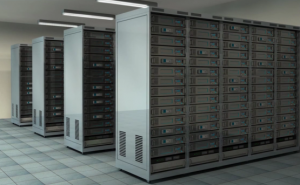
Another strength highlighted by Nanopore is the ability of the machines to react in real time, changing aspects of their behaviour depending on the orders given during sequencing.
Some of these adaptations will be automatic quality-control changes, for example, the salt concentration and the temperature can change to optimize efficiency and quality.
The machines can also be given basic preset targets which means that you can run the machine until you have what you want, rather than running it for a set period of time.
These machines can handle up to 96 different samples simultaneously, so you can decide to sequence one sample until you have enough DNA from it, then move onto another one, and so on.
The machines can communicate with each other, so four machines could sequence the same sample, and stop once they had produced enough sequence between them.
It goes without saying that the cost and accuracy will play a significant role in assessing how strong a prospective machine would be.
However, providing the throughput is high enough, the fact that the technology is single molecule should keep the enzyme cost down.
Ultimately, these machines continue to lead the way in cluster sequencing, providing maximum efficiency.
For more information on the system, see the website. They have also produced a helpful video that explains the system:
I agreed to make my 23andMe genotyping results available publicly as part of GNZ because I knew that the results were slightly dull, and I’m not majorly at high or low risk for any diseases.
I was also very unsurprised to find out that I have blue eyes and that I was identified to be most likely descended from Northern European Ancestry.
A few hours after releasing the data, I was directed to Dienekes Pontikos’ post, where they wrote about the results of running all our data through his ancestry prediction program.
Most people were predicted to be of Northwestern European descent, and I was given an estimate of 20% Ashkenazi Jewish ancestry. When asked about this, I had no answers to give and instead decided to do my own research.
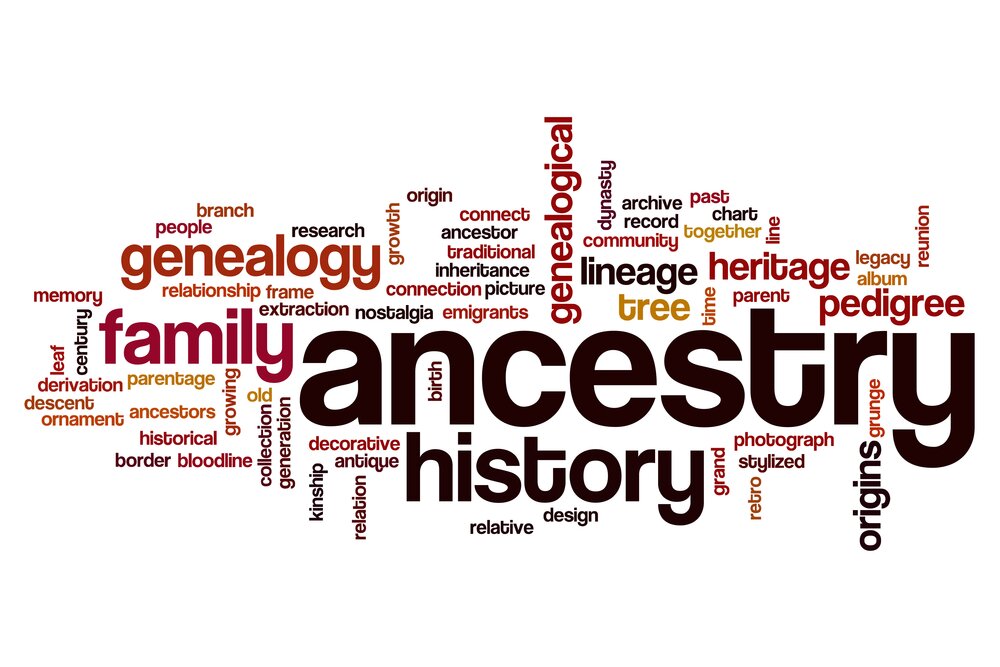
This program is based on a paper that explores the differences in allele frequencies in European Americans.
In the study, the authors identified two main components of variation in ancestry that corresponded to three groups: Mostly northwest European descent, southeast European descent, and Ashkenazi Jewish descent.
They created a list of 300 genetic markers that gave information about the ancestry in the sample, which was made publicly available.
The program uses those allele frequencies at the level of markers in the 23andMe platform to infer the proportional membership of an individual from each group.
If someone has the genotype CC at an SNP, and the C allele has 20% frequency in northwestern Europe and 60% frequency in Ashkenazi, the person is more likely to be Ashkenazi. This method put me at 20% Ashkenazi ancestry, but with not enough data to make this a confident statement.
The question left to be answered is ‘what does this mean?’ It doesn’t mean that I have 20% Ashkenazi ancestry; it means that I carry the alleles that are rare in Europe and more common in the Ashkenazi Jewish population.
However, this is based on the assumption that my ancestry only goes back to these three locations.
Knowing that I had a grandparent of Italian descent, I tested for southern European ancestry. It is also commonly known that southern European populations are similar to the Ashkenazi populations in relation to genetics.
In order to explore how the GNZ participants relate to European populations, I was able to combine multiple data sources. These were from the Human Genome Diversity Panel, the 12 GNZ individuals, and a set of Ashkenazi Jewish individuals.
They were all genotyped on Illumina arrays. To begin to look at the relationships between these individuals, I used the smartpca program to look at the average genetic relationships between the populations.
In the below plot, each point is an individual on the most important axis of genetic variation in this sample. The Ashkenazi population is blue, and the GNZ individuals are black.
Dan is with the Ashkenazi population, Vincent with the French, and me with the French on component 1 and the Italians on component 2.
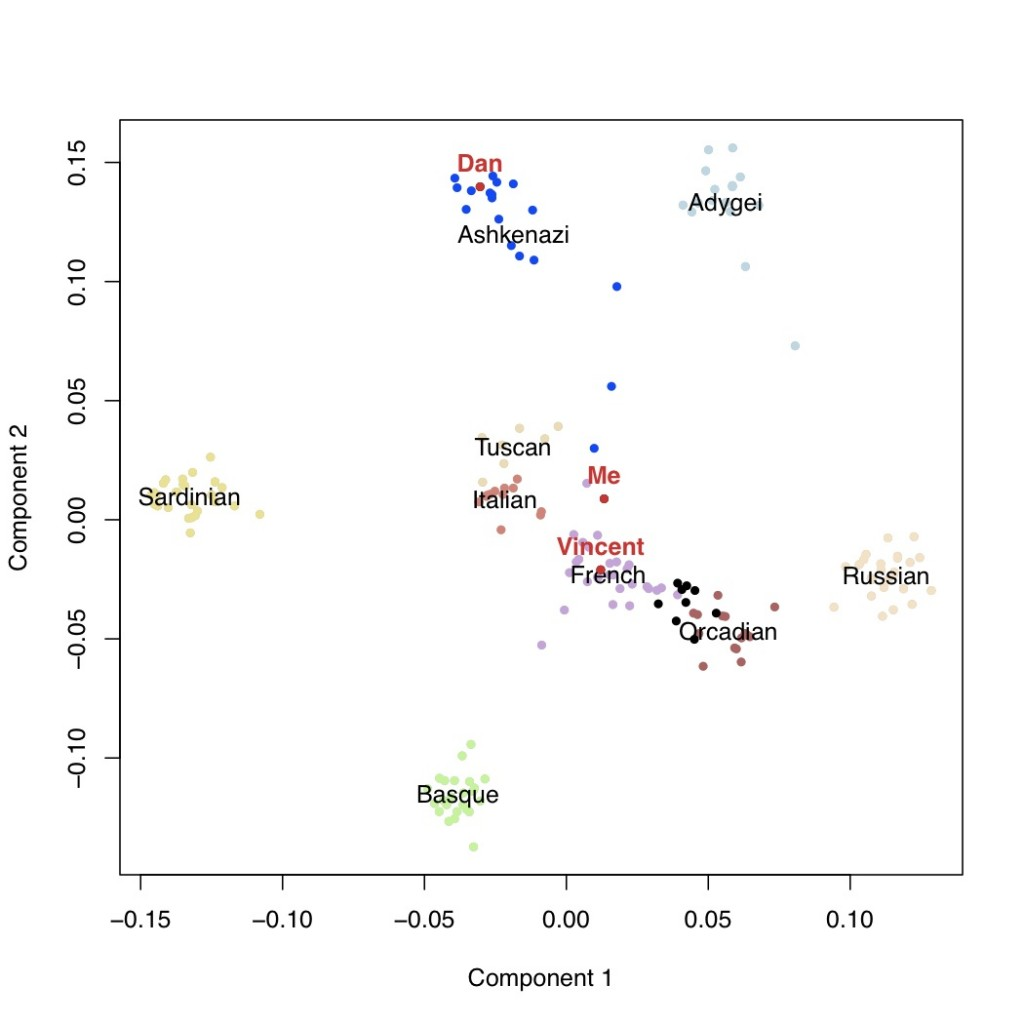
Next are the additional components of variation with the second versus third components, followed by the third versus the fourth.
The fourth axis of variation separates the Ashkenazi population from the rest of Europe.

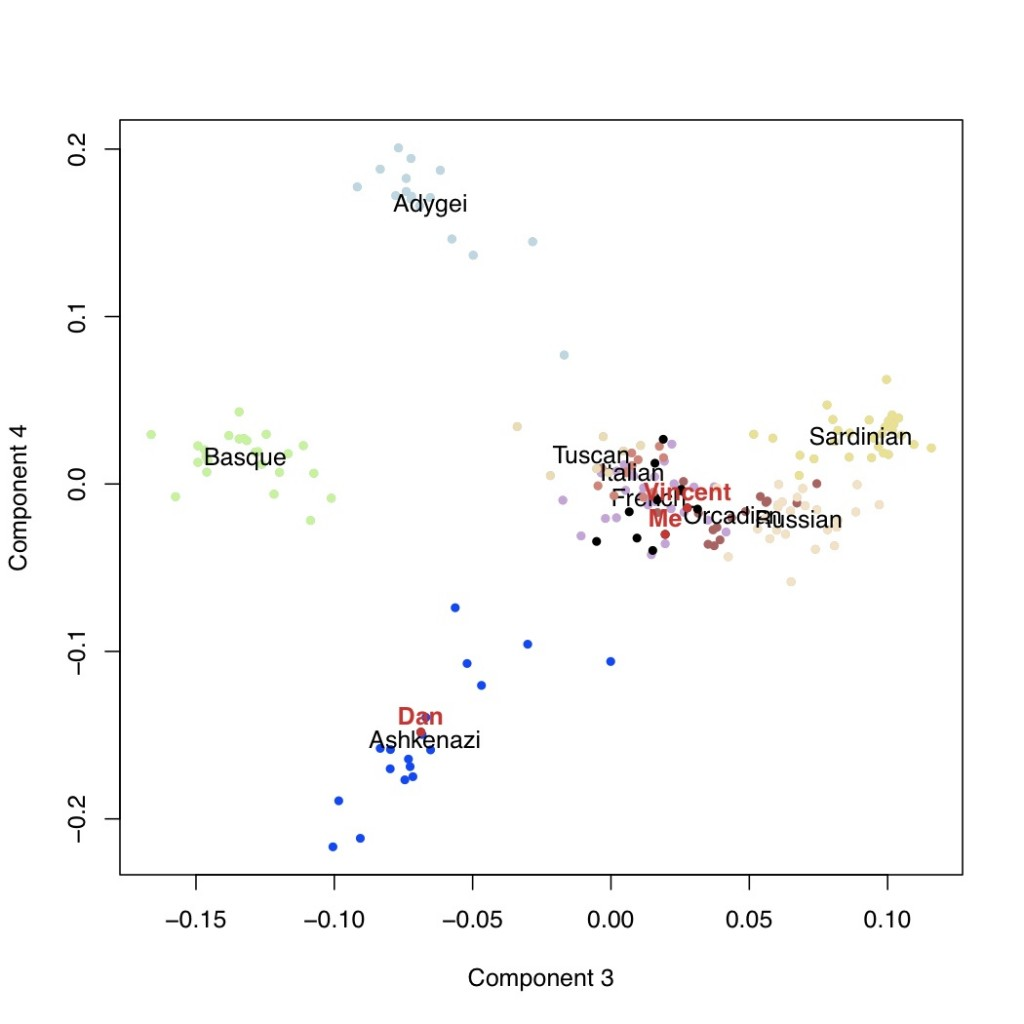
The analysis suggests that I do not have any Ashkenazi Jewish ancestry, and the results were actually hidden south European ancestry.
I have satisfied my curiosity surrounding my knowledge of family history, and it seems I have a small amount of south European ancestry mixed with a large amount of northwest European ancestry.
At the annual Advances in Genome Biology and Technology (AGBT) conference held in Florida during 2012, there were many exciting announcements and developments in the world of DNA sequencing technology.
An especially cool piece of news came from the team at Oxford Nanopore, the stars of our piece on cluster sequencing, about their (then) brand new sequencing machine.
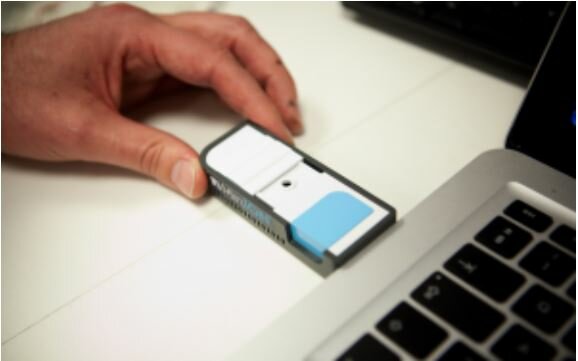
Much of the hype surrounded the focal point of the above image, a MinION. No, we don’t mean those banana loving yellow fools, but in fact a minuscule, disposable USB-key sequencer, capable of sequencing a whopping one billion base pairs of DNA from the comfort of your own lap.
Though it was initially a pricey purchase at between $500 and $900, its applications were seemingly endless. Being able to take some biological matter, combine it with a couple of chemicals, and then read its DNA was considered revolutionary. By no means affordable, it was the first tentative step into DNA experimentation at home.
A second, slightly less exciting but equally as intriguing announcement, was that of the GridION sequencing machine.
Built to read a great deal of DNA to scale up at humongous sequencing centers, it was able to read long strings of data that had previously been unthinkable (at least in a way as reliable as the human brain!)
What implications did these products have on those with a personal interest in genomics?
According to their estimations, one GridION machine, also referred to as a node, could read sequence as fast as 600 million base pairs an hour, the equivalent of 14GPB per day, and read high coverage (30x) human genome in less than six days.
Stacking up four nodes, you could therefore produce sequences working at a similar rate to Illumina’s high-end HiSeq 2500 machine.
At around $2200-$3600 for each genome, the machine was considered a new competitor in terms of throughput, data quality, and expenses, which at the time was a pretty sizeable achievement in comparison to the major sequencing companies from a smaller producer.
What was particularly clever about Oxford Nanopore’s inventions was that they avoided some of the difficulties traditionally found in DNA sequencing; each sequencer was tiny and stacked efficiently, with 20 units equating to the size of a traditional HiSeq at only a fifth of the footprint per genome.
Power consumption was also considerably reduced, and preparing DNA for sequencing takes moments as opposed to days of processing and much more expensive equipment. When people examine this company retrospectively, they will be able to clearly recognize their contribution to the simplification of genome sequencing.
This wasn’t just about reducing the cost - though they did, by a staggering 20% - but making at-home, outside the lab sequencing a possibility altogether. Nobody thinks about the price decrease in recent years, but everyone certainly remembers when Oxford Nanopore used a laptop computer to sequence rabbit DNA.
Alzheimer’s disease is a form of dementia that impacts the brain and results in memory loss. In recent years we have been able to study it and its risk factors to calculate the chances of you being affected by the disease. Today we are going to look at how that risk is calculated.
Most people who develop Alzheimer’s are elderly and near the end of their lives. However, this is not always the case. Looking into calculating your risk can be interesting and done using APOE environmental factors and other risks.
It is important to remember that this number is not absolute and can be subject to change. If you are concerned, make sure to consult your doctor.

The Apolipoprotein E (APOE) gene works to protect against Alzheimer’s. The gene has different alleles, some work to protect you from Alzheimer’s, whereas others increase your risk. We all have two copies of this allele, and it's this combination that can determine your risk.
You can find this information out by having genome testing done or speaking to a healthcare professional. If there is a history of Alzheimer’s in your family, it may be offered to you.
Even without genotyping, you can work this out yourself by using genetic programs such as Beagle, which can help give you an odds ratio of developing Alzheimer’s at some point in your life.
APOE is a significant genetic risk factor for Alzheimer’s, but it is not alone. The below table shows five other variants.
|
Gene |
Variant |
Risk Allele |
0 |
1 |
2 |
|
CR1 |
rs3818361 |
A |
0.89 |
1.10 |
1.35 |
|
CLU |
rs11136000 |
C |
0.83 |
0.97 |
1.12 |
|
PICALM |
rs541458 |
T |
0.75 |
0.92 |
1.13 |
|
ACE |
rs1800764 |
T |
0.83 |
0.98 |
1.16 |
|
CST3 |
rs1064039 |
C |
0.75 |
0.90 |
1.08 |
The odds are calculated by counting the risk alleles for each variant and times them for all variants.
You can combine this with APOE odds ratios, which will provide a more accurate odds ratio of developing Alzheimer’s.
Environmental factors won’t influence Alzehimer’s as strongly as APOE, but they are still factors to be aware of.
Most of these risks apply to older people and include vascular disease and head trauma, for example.
Other risk factors apply more widely, such as physical activity, education, and alcohol consumption. The below table looks at these risks.
|
Risk Factor |
Class |
OR |
|
Education |
0-8yrs |
1.36 |
|
9-12ys |
0.98 |
|
|
>12yrs |
0.72 |
|
|
Regular Exercise |
Yes |
0.89 |
|
No |
1.28 |
|
|
Alcohol consumption |
Yes |
0.73 |
|
No |
1.27 |
Some research into genetics and the environment has been done, but not enough to present to you today.
We can consider genetics and the environment separately to multiply ratio odds to get an overall odd ratio.
Using 23andMe’s v2 chip, we can assess the APOE risk through genotype imputation. From this, we can infer a predictive medical factor by using ‘non-medical’ variants. There is the issue of privacy with this and any attempt to separate the medical and non-medical information.
So what do we do with the information? While there is no concrete preventative measures and limited treatment options, it’s down to lifestyle.
Regular exercise and eating less fat and red meat can work to help reduce your risk. As everyone’s risks are different, it’s not necessarily the holy-grail answer for everyone.
It is worth checking with a healthcare professional if you are unsure of what you can do.
A little while back, Razib Khan used data from 23andMe to explore his family’s genetic history. He previously published his findings and summarized them. Today, I’m going to fill you in on what he had to say!
Khan was interested in genetics, anthropology, and history, mainly how we have changed the way lineages are marked thanks to the increase of technology. This developed a curiosity for Khan to learn more about his genome.
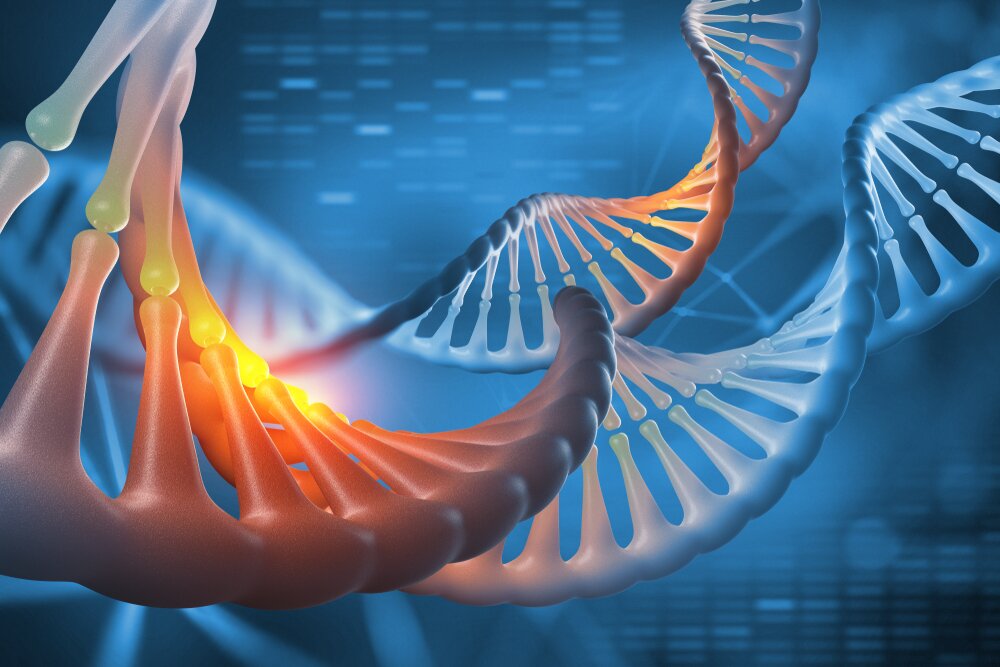
Khan’s family are from the Comilla district in Bengal; all four of his grandparents were ethnic Bengali’s, and appearance-wise, he looks typically South Asian. He had some skepticism about the test and his genome.
Khan comes from a large family, where both his parents have many siblings. The large family has allowed Khan to have already a sense of his risks for certain diseases, along with the knowledge of his family’s medical history.
Skeptical but curious, Khan tried out 23andMe during a sale offer. Expecting a generic result, Khan was surprised by the results. 23andMe’s ancestry painting algorithm.
This calculated Khan as 57% European, 43% Asain, and less than 1% African. Initially, Khan thought the Asian percentage was a little high, so he asked to see whether other South Asians had received such a high value. The answer was none had.
From his ‘gene sharing,’ he found that generally, the Asian range from 23andMe’s algorithm was 10-35%. The lower portion of this percentage was from people in the northwest of the Indian subcontinent.
Those higher values were coming from the east and south. Intrigued by this, Khan consulted the paper Reconstructing Indian History, which explained this wide percentage range.
The paper explained that South Asians are a combination of the European-like population and a marginally Asian-like population, made up of Ancestral Northern Indians (ANI) and Ancestral South Indians (ASI).
The former’s mixture went from 75% in the northwest to 45% in the far south. The paper cites the class system as a contributing factor to this. Khan assumed that his high Asian percentage was due to having more ASI than the norm.
There was skepticism towards this due to the Comilla district borders, which would indicate that he has Tibeto-Burman ancestry that he may not have been aware of.
Neither of his parents was aware of a potential link, and 23andMe does not offer a more detailed response, leaving Khan with some uncertainty.
Khan decided to use 23andMe to genotype his parents and gain more insight into his family's heritage. During the waiting time, he spoke on his blog about his predicted outcomes of these tests.
Khan initially thought that his father’s heritage might have been different from what they believed and wrote some extensive blog posts on this issue. The results from 23andMe stated that his father was less Asian than his mother.
Khan ran their date through ADMIXTURE and EIGENSOFT using various parameters, and overwhelmingly the results said that his mother was more Asian than his father, leaving him with conflicting advice.
Khan returned to the drawing board, looking at oral histories from both sides of the family, consulting origins of Tibeto-Burman ancestry and the possibility of eastern Bengali Muslims being in his lineage.
From his research, he concluded that he had no real change in terms of his self-conception, but rather Khan was now intrigued by historical population genetics instead of scientific genealogy.
Khan concluded that although not much was revealed to him about his family, it is a hobby he has decided to keep hoping that more knowledge will become available in the future.
In May 2019, it was reported in an article that over ten thousand sequence mismatches were observed between messenger RNA and DNA from the same individuals.
More recently, three technical comments were published by Science surrounding this article. It was concluded that at least 90% of the Li et al. RDD sites are technical artifacts. Here, we are going to explain how this conclusion was drawn.
For each RDD site that had at least five reads mismatching the genome, it was calculated that the fraction of reads with the mismatch, or the match, at each position in the alignment of the RNA-seq read to the genome on the + DNA strand.
Over 10,000 exonic RDD sites were found, which included thousands of RDD sites that were predicted to change protein sequence. These results actually implied the existence of a minimum of one, if not more, novel mechanisms of gene regulation.
This questioned some of the basic assumptions that are used daily in genetics.
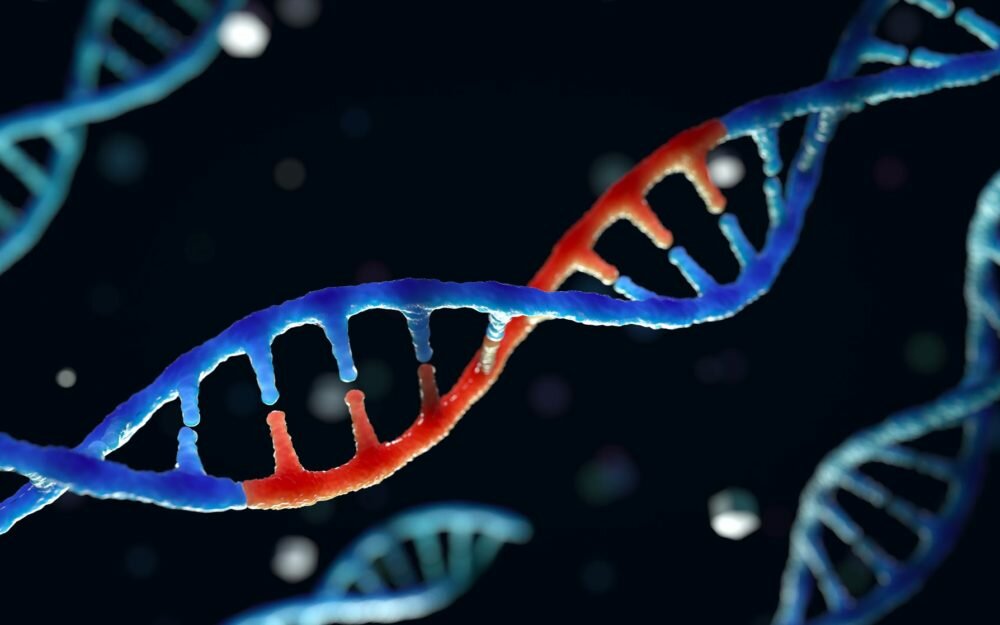
It turns out that it is not the existence of RDD sites that was so surprising; it was the significant biological impact of the sites and the subsequent implication that there are new regulatory pathways that were not previously known to us.
The reason that some think that all of the RDD sites in Li et al. are false positives is that two groups have raised issues regarding the reported RDD sites. Both of these sources claimed that the majority of the sites presented in the findings were false positives.
Actually, mismatches to the genome at RDD sites are almost always occurring at the ends of sequencing reads. All three of the technical comments that were made after the paper was published had included this observation.
In response to the comments being made, a plausible explanation was proposed for the observations. To generate the cDNA, they added random short DNA sequences to each sample that acted as a primer for a DNA synthesis reaction.
At some sites, the random primers were not perfect matches to the mRNA, but they were still able to bind. During synthesis, the mismatches from the primers were incorporated into the cDNA, and this, in turn, led to a false signal of RNA editing. This explains the previous results.
Another exercise that aimed to validate the finding had involved identifying peptide sequences that correspond to ‘edited’ RDD sites. It was pointed out that many of these sequences are actually good matches to multiple genes.
It was concluded that these RDD sites are false positives due to mismatched reads from paralogous genes.
In conclusion, when looking for regions of the genome that look strange during an analysis, an individual will find strange and unexpected results. This applies even when a systematic error only affects 0.001% of the bases in the genome.
It turns out that the most interesting findings are actually less likely to be real. This was discovered through the process of finding false positives and mismatched results.
However, it does remain a possibility that forms of RNA editing that have not always been known are active in humans, and RNA sequencing technology can be helpful in finding out if new forms do exist.
The common notion running through molecular biology is that the information present in DNA is transferred to RNA and then to protein.
Back in 2010, researchers made a potentially ground-breaking observation.
They found that within any given individual, there are tens of thousands of places where transcribed RNA does not match the template DNA from which it is derived.
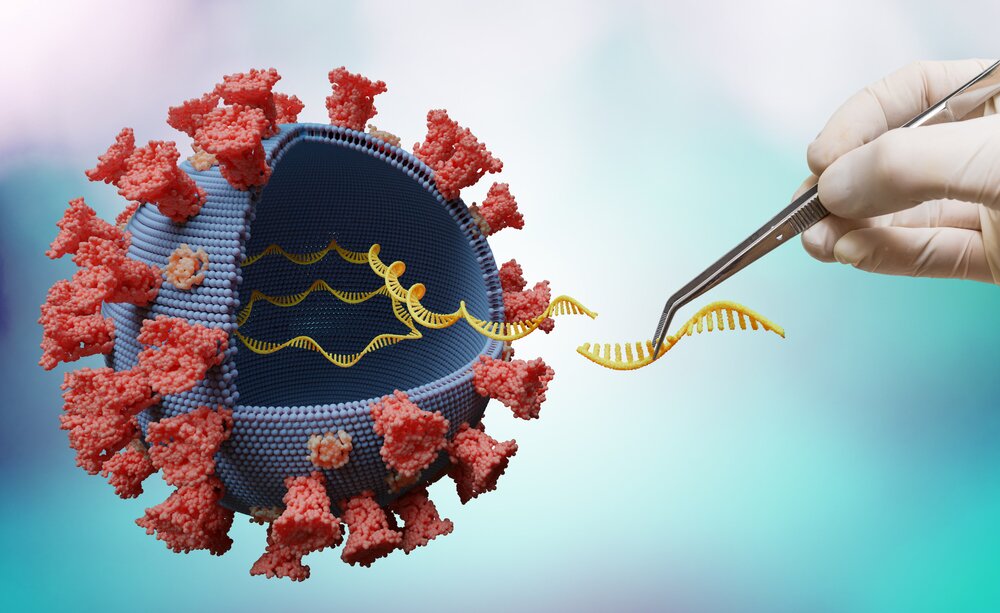
In humans, it is generally thought to be limited to conversions of the base adenosine to the base inosine (which is read as guanine by DNA sequencers), and occasionally from cytosine to uracil.
However, these authors reported something new. They found that any type of base can be converted to any other type of base. If their observations are correct, these findings represent a fundamental change in how we view the process of gene regulation.
The authors of this study sequenced the mRNA expressed by an individual (or rather, cDNA from a cell line derived from the individual). They then obtained DNA sequences from the same individual and compared the two.
Any difference between the RNA and DNA was taken as an indication of RNA editing. However, because it is impossible to sequence an entire mRNA or genome in a single pass, the researchers used short reads (of 50 bases) from the mRNA of the individual and reads of various lengths from the DNA of the individual.
They then matched these sequencing reads to the genome (or transcriptome) to see where they came from.
However, there are several complications with this method: choosing the best spot to take reads from involves several assumptions, including how you weight insertions and deletions and possible sequencing errors.
These sorts of mapping issues are well understood and have been widely discussed in the literature on SNP calling from sequencing data, which is another situation where the researcher is looking for a difference between a sequencing read and the genome.
A naïve SNP caller that just looks for differences between aligned reads and a genome will output tens (or probably hundreds) of thousands of false-positive SNPs which must be filtered out by various criteria.
Therefore, mismapping of reads in paralogous regions can lead to false signals of RNA editing, and these false signals can even be replicated in follow-up experiments like those done by Li et al. (2011).
This is because the two forms of RNA and protein are indeed present in the cell, giving the illusion of RNA editing.
However, the two forms of RNA and protein do not come from the same DNA sequence, and thus are not evidence of RNA editing.
Besides, mapping biases around splice sites (and other sorts of insertions/deletions in the genome) will cause mismapping and false inference of RNA editing.
So in conclusion, while RNA editing is a potentially important phenomenon in humans, there is significant scope for further research, and skepticism of studies carried out so far certainly seems warranted.
This was once a guest post by Karol Estrada, who was a postdoctoral research fellow in the Analytic and Translational Research Unit at Massachusetts General Hospital and the Broad Institute of MIT and Harvard.
It was written in memory of Laura Riba. We have briefly summarised her thoughts and findings from that post below.
Karol discusses her new paper, which was published in the Journal of the American Medical Association. It discusses the low-frequency missense variant in the gene HNF1A that increases the risk of type 2 diabetes by five times and was only seen in Latinos.
It was the largest study to date, with a sample of nearly 4,000 people. They undertook whole-exome sequencing of 1,794 type 2 diabetes cases and 1,962 healthy controls from four studies of Mexicans and also Latinos.

A paper from 2013 called Nature found that a set of four variants in the SLC16A11 gene increases the risk of type 2 diabetes. The variants are from the same haplotype which is common in people from Latin America but rare in people of European ancestry.
In accordance with the Nature paper, their JAMA study reinforces the importance of studying populations that have not yet participated in genomic research. They found the low-frequency variant HNF1A in 2% of type 2 diabetes cases and 0.4% of healthy controls.
This is the largest ever effect seen of a type 2 diabetes variant that’s found in more than 0.1% of the population. The variant was only identifiable in Latio people as well and could not be found in public genetic databases.
Their study did not find any other low-frequency or rare variants associated with type 2 diabetes above genome-wide statistical significance, the HNF1A was the only one.
However, they did note that to identify rare causal variants will require a higher sample of cases and controls, often in the tens of thousands.
The variant HNF1A that they discovered has indications beyond its design insinuating that a case study into how perceptions of the disease are not subtle enough to match reality.
HNF1A is one of the 13 known MODY (maturity-onset diabetes of the young) genes, however, the people who carried the HNF1A gene in their study don’t have the typical recognizable attributes of MODY.
These people look more than like regular type 2 diabetes patients who are either overweight to obese and who developed diabetes later on in life, additionally not everyone who carried the HNF1A variant had diabetes, they found 12 carriers who were completely healthy.
They soon discovered that MODY and other rare diseases are a lot more complicated than they initially thought, this was backed up by a previous study at the Framingham Heart Study that showed that 1.5% of the randomly selected participants carried the MODY mutation but had completely normal glucose levels.
This reinforces that mutations of rare diseases can also be identified in healthy people, but because studies have only been done on the mutations in people who have diseases, it’s hard to clarify.
The article concludes with them stating how much work remains to still be done in this area but also puts forth the idea that genotyping a single low-frequency variant could help hundreds of thousands of people suffering from not just diabetes, but other deadly diseases whilst also contributing to the reduction of the cost of healthcare.